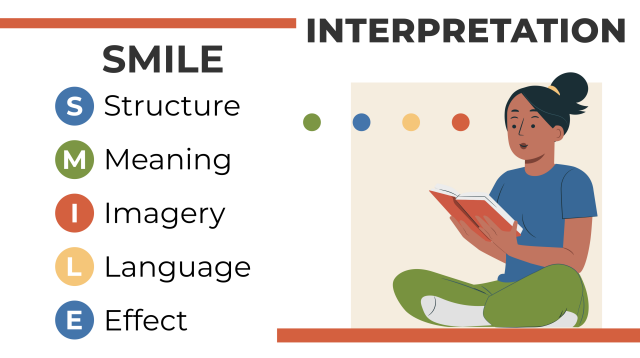
Literary Interpretation

Next, we will learn a simple, structured approach to interpreting literary works effectively — employing the SMILE method.
Introduction
In our previous lessons, we explored the major literary periods and their characteristics, and we discussed the importance of understanding the cultural and historical contexts of literary works. Now, we will delve into the practical process of interpreting literature. Whether you’re analyzing a poem, short story, or essay, the SMILE method can guide you through a step-by-step approach to gain a deeper understanding of the text.
Step 1: S – Structure Analysis
Begin your interpretation by examining the structure of the literary work. Consider elements such as the format, narrative point of view, and organization. Ask yourself:
• What is the genre of the work?
• Who is the narrator, and what perspective do they provide?
• How is the work organized? Are there distinct sections or chapters?
Step 2: M – Meaning Exploration
Once you’ve grasped the structure, focus on extracting meaning from the text. Think about the central message or theme the author conveys. Consider these questions:
• What is the primary message or theme of the work?
• Are there underlying messages or subthemes?
• How do the characters and events contribute to the overall meaning?
Step 3: I – Imagery Investigation
Now, delve into the use of imagery and sensory details in the work. Visualize the scenes, emotions, and situations the author describes. Pay attention to:
• Vivid descriptions, sensory language, and figurative speech (similes, metaphors, symbols).
• How the imagery affects your emotional response and understanding.
• The role of setting and atmosphere in conveying the message.
Step 4: L – Language Scrutiny
Analyze the language and word choices the author employs. The author’s use of specific words and phrases can be significant. Ask yourself:
• Are there words with multiple meanings or connotations?
• How does the author’s choice of language contribute to the mood or tone of the work?
• What literary devices (e.g., similes, metaphors, alliteration) enhance the text?
Step 5: E – Effect Evaluation
Finally, evaluate the overall effect of the literary work. Reflect on the emotional and intellectual impact it has on you as a reader. Consider:
• Your emotional response, including any memorable or poignant moments.
• How the work’s themes and messages relate to your own experiences or beliefs.
• What the work made you think, feel, or question.
Conclusion
By following the SMILE method, you can systematically interpret literary works, gaining a deeper understanding of their structures, meanings, imagery, language, and overall effects. Practicing this approach will enable you to become a more insightful and engaged reader, better equipped to analyze and appreciate a wide range of literary genres.
For your next assignment, read David Foster Wallace’s “This Is Water.” You will use the SMILE method to interpret the speech, providing insights into its structure, meaning, imagery, language, and effects.

